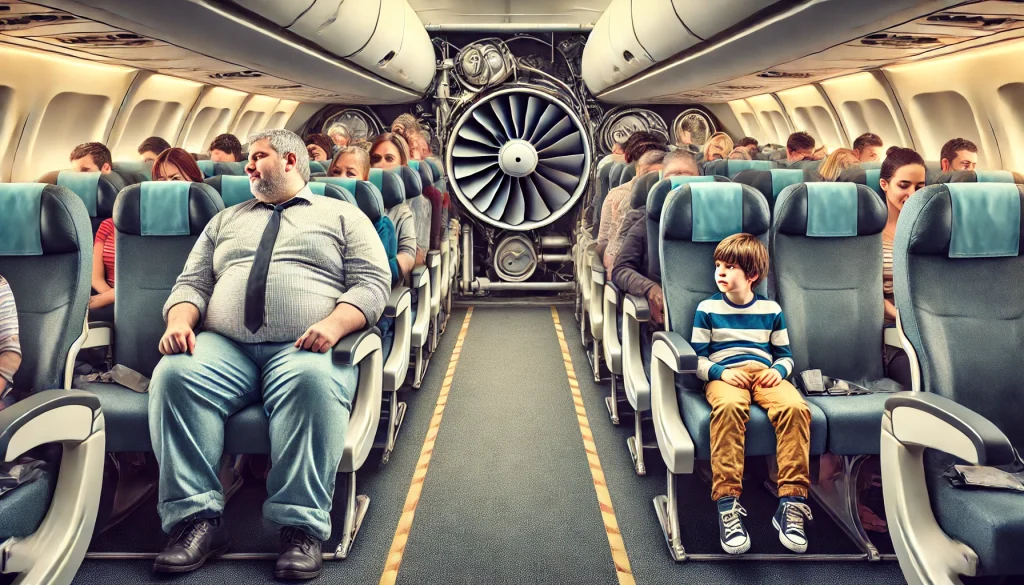
Travel and Tourism: The aviation industry is often lauded for connecting the world, bringing distant places closer and making travel accessible to millions. However, beneath this veneer of convenience and connectivity lies a darker truth: airlines are cheating you in more ways than you might realize. From cramped seating arrangements to half-baked airplane designs, the greed of this industry is both pervasive and alarming.
Crammed Spaces: The Uncomfortable Reality
One of the most blatant ways airlines cheat passengers is by maximizing profit through cramped seating arrangements. The “one size fits all” approach is the industry’s standard, which is fundamentally flawed. A 250-pound man and a 12-year-old child are expected to fit into the same seat size, leading to discomfort and dissatisfaction. This policy is driven purely by profit. Airlines aim to fit as many passengers as possible into the smallest space, sacrificing comfort for revenue. This results in cramped legroom, narrow seats, and a general lack of personal space. Despite the discomfort, this practice continues unabated, significantly boosting the airlines’ bottom line.
Looking the other way: Lack of Consumer Advocacy
Surprisingly, consumer advocacy groups pay little attention to this glaring issue. While there are organizations dedicated to various consumer rights, the specific plight of airline passengers often goes unnoticed. The lack of vocal and organized opposition allows airlines to continue their profit-maximizing strategies without fear of backlash.
Passengers have become desensitized to the discomfort, accepting it as an unavoidable part of air travel. This resignation and a lack of solid consumer groups highlighting the issue perpetuate the status quo. It is a cycle of exploitation where airlines thrive on the passengers’ silent suffering.
Half-Baked Airplane Designs: A Recipe for Disaster
Beyond uncomfortable seating, modern airplane designs are often rushed and incomplete. This rush to market can lead to catastrophic consequences. Over the years, numerous flawed airplane designs have resulted in tragic accidents. The greed to introduce new models quickly often overrides the imperative for thorough testing and validation.
One of the most glaring issues in modern airplane design is the lack of proper engine covers. Engines are vulnerable to bird strikes, which can cause significant damage and even lead to engine failure. Despite this known risk, many modern engines lack adequate protection against such incidents. This oversight is not due to a lack of technology but a calculated decision to cut costs and maximize profits.
The Invisible Hand of Greed
The overarching theme in the airline industry’s operations is greed. From the moment a passenger books a ticket, they are subjected to a series of money-making schemes. Baggage fees, seat selection charges, and in-flight purchases are all designed to extract as much money as possible from passengers.
The most insidious aspect of this greed is how it has become normalized. Passengers expect to be nickel-and-dimed at every turn and accept it as a part of air travel. This acceptance is precisely what airlines bank on, ensuring a steady stream of revenue from these supplementary charges.
Safety Compromises: The Unseen Cost of Profit
The drive for profit extends beyond passenger comfort and into safety. There have been instances where airlines have cut corners on maintenance and safety protocols to save money. These compromises can have devastating consequences, putting passengers’ lives at risk.
For example, the Boeing 737 MAX crisis highlighted how safety can be compromised in pursuing profit. The rushed development and certification of the aircraft and insufficient pilot training on new systems led to two fatal crashes. This tragic example underscores the dangers of prioritizing profit over safety.
One of the most glaring issues in modern airplane design is the lack of proper engine covers. Engines are vulnerable to bird strikes, which can cause significant damage and even lead to engine failure. Despite this known risk, many modern engines lack adequate protection against such incidents. This oversight is not due to a lack of technology but a calculated decision to cut costs and maximize profits.
The Need for Change
The current state of the airline industry demands immediate and urgent change. Passengers should no longer have to endure discomfort and safety risks for the sake of corporate profit. A concerted effort from consumer advocacy groups and regulatory bodies is needed to address these issues.
Stricter regulations should be implemented to ensure minimum seat sizes and legroom tailored to different passenger demographics. Safety standards need to be stringent, with no compromises allowed for speed or cost savings. Moreover, airlines should be held accountable for their actions, with penalties for those who put profit before passengers.
Conclusion
The aviation industry’s unchecked greed is a disservice to the millions of passengers who rely on air travel. From cramped seating to unsafe airplane designs, how airlines cheat their customers is numerous and troubling. It’s time for passengers to demand better, for consumer groups to take a stand, and for regulatory bodies to enforce stricter standards. Only then can we hope to see an industry that truly serves the needs of its passengers, prioritizing their comfort and safety over profit?
